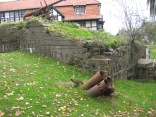As I had mentioned in a previous post: My hotel Hotel Ieper Kasteelhof’t Hooghe was located in Hooge about 4 km outside Ypres and I was to discover that the hotel was actually on the site of the old stable buildings to the original Château de Hooge (home of the Baron de Vinck) on the Bellewaerde Ridge. The ridge had been the site of intense and sustained fighting between German and Allied forces for the entirety of the WWI. The following table illustrates some of the major moments during that fighting.
|
1914 |
The British had their Headquarters here. |
|
30th October 1914 |
Six British staff officers were killed by shellfire whilst in a conference at the chateau. |
|
21st February 1915 |
The Germans exploded an underground mine at Hooge. |
|
May 1915 |
The chateau was captured by the Germans for the first time. |
|
19th July 1915 |
The British exploded an underground mine which left a crater 16 metres deep and 40 metres across. A specially formed tunnelling company had burrowed 65 metres to a position beneath a German strong-point and planted nearly two tonnes of Ammonal, the most powerful explosive of the time. The crater was immediately rushed and occupied by the British infantry. Today the crater is a small lake just in front of the hotel. |
|
30th July 1915 |
The Germans, using flamethrowers, captured the crater and adjacent trenches. This was the first use of flamethrowers against British troops. |
|
9th August 1915 |
Despite heavy losses the British succeeded in recapturing the crater although the shattered remains of the chateau, only a hundred metres away, remained in German hands. |
|
25th September 1915 |
A British attack at Hooge failed at a cost of some 4000 casualties. |
|
6th June 1916 |
As part of a larger attack and with the detonation of four more underground mines, the Germans captured all the British positions at Hooge. |
|
Night of the 12th July 1917 |
Mustard Gas was used by the Germans for the first time. |
|
31st July 1917 |
The start of the Third Battle of Ypres. Hooge was recaptured by the British. |
|
21st March 1918 |
As part of their Spring Offensive the Germans recaptured Hooge and almost took Ypres. |
|
28th September 1918 |
Hooge was captured for the last time by the British 86th Brigade, under the overall command of the King of the Belgians and pushed the Germans eastwards towards Germany and the Armistice. |
The summer of 1915 must have been horrific with the constant back and forwards nature of the fighting here. The ground lost and gained was no more than 100 metres with the horrific cost of lives (4000 in one day in September 1915). The site witnessed some of the most abominable moments in industrialised warfare. The first use of flame throwers, underground mines (see also my post “The victory at Messines Ridge“) and the first use of those terrible weapons of mass destruction – mustard & chlorine gas.
And here sits my hotel! What a place.
Why do I bring this up, well the grounds of the hotel were littered with well preserved remains of the trench warfare that took place here. The beautiful little lake in front of the hotel is actually the crater of the largest of the underground mines exploded here. The area around the hotel has been turned into an open air museum where you can wander and appreciate the scale of the madness. In places the opposing trenches were only 15 metres apart. Angled out of the ground in places are the remains of the mortars used to fire the gas cylinders. Decaying ammunition (inactive) litters the area. Digging in the ground is strictly forbidden as the ground is filled with human remains. This equates for me on the same scale as the killing fields of Cambodia I visited in 2014.
You cannot wander sites like this and not be affected. Unfathomable to me – the blind madness of it all. How could commanders like Field Marshall Haig commit 100s of thousands of soldiers to such atrocious conditions with horrific outcomes – the philosophy of the war of attrition. It boogles the mind to think they believed this was they way to win the war against industrialised weapons. However, I should not be surprised, as the only qualification you needed at the time to be a commanding officer in the high command seemed to be that you were a born member of the British aristocracy. No wonder the NZ commanders felt frustrated at not being allowed to lead their men and influence the battle strategies, and having to answer the orders of incompetent British aristocrats. However, when left to carry out tasks assigned to them without interference from the high command the ANZACs achieved some of the major breakthroughs of the war through their own initiatives (e.g. Messines Ridge).
Frustrating and noble thoughts while standing amid the remnants of such carnage. How could the recruiters of the time sell this to the lads down under as “a chance to see the world”. Easy for me to stand here 100 years later with my noble thoughts and critise, I was simply wasn’t around at that time. Glad I wasn’t, but it made me cry to think of all those young men in their twenties who never got to enjoy the benefits and advantages of the life I have had.
With this myriad of thoughts in my head I was glad to get out the trenches and to cross the road to the Hooge Crater Cemetery and pay my respects once again. I would be haunted by these trenches for the rest of my stay as my room was just 10 metres from them and as I drew the curtains every morning I would look straight in to them.
















